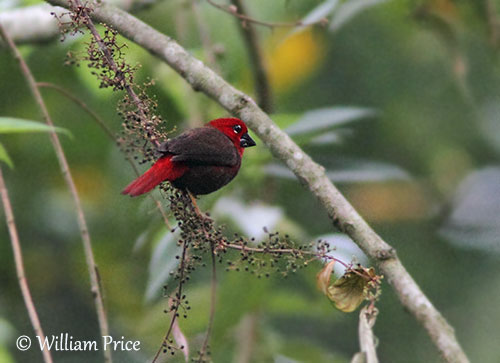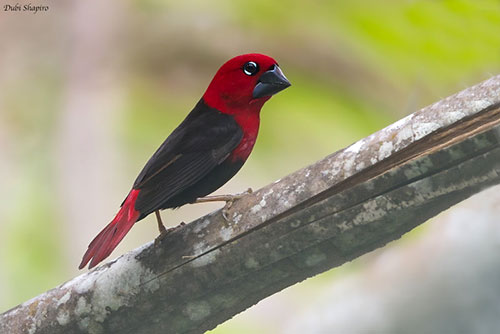
Fr: Pyréneste ponceau
Ang: Black-bellied Seedcracker
All: Purpurastrild
Esp: Estrilda Piquigorda Ventrinegra
Ita: Spaccasemi pancianera
Nd: Purperastrild
Sd: svartbukig astrild
Photographers:
William Price
PBase-tereksandpiper & Flickr William Price
Jean Marc Rabby
Des Ailes et des Plumes
Dubi Shapiro
Dubi Shapiro Photo Galleries
Text by Nicole Bouglouan
Sources:
HANDBOOK OF THE BIRDS OF THE WORLD Vol 15 by Josep del Hoyo-Andrew Elliot-David Christie - Lynx Edicions – ISBN: 9788496553682
BIRDS OF AFRICA SOUTH OF THE SAHARA by Ian Sinclair and Peter Ryan - Princeton University Press Princeton and Oxford - ISBN: 0691118159
BIRDS OF THE GAMBIA AND SENEGAL by Clive Barlow and Tim Wacher – Helm Field guides – ISBN: 0713675497
FINCHES AND SPARROWS by Peter Clement, Alan Harris and John Davis – Helm Identification Guides – ISBN: 0713652039
The Birds of Africa: Volume VII – Illustration: Martin Woodcock, Ian Willis, C. Hilary Fry – Collaborateurs: C. Hilary Fry, Stuart Keith – Editeur: Bloomsbury Publishing, 2020 – ISBN: 1472986563, 9781472986566 – 724 pages
Cracking the problem of bill size
Technology Networks – Genomic research
Evolution of Resource Polymorphisms
Development of beak polymorphism in the African seedcracker, Pyrenestes ostrinus
Comparative Breeding Biology of the Two Bill Morphs of the Black-Bellied Seedcracker
Wikipedia, the free encyclopaedia
Black-bellied Seedcracker
Pyrenestes ostrinus
Passeriformes Order – Estrildidae Family
INTRODUCTION:
The Black-bellied Seedcracker is a beautiful, bright-coloured bird native to Central Africa.
It frequents the tropical rainforest of Africa, and during the breeding season, it nests near swamps, marshes, ponds and other moist habitats. But as a very adaptable species, it may also occur in drier habitats including grassland, savanna and shrubland.
The Black-bellied Seedcracker feeds on seeds from various plant species. Its diet is related to each season, and seeds, berries, insects and green leaves are taken. But as usual, the chicks are fed with soft insects.
The Black-bellied Seedcracker is monogamous during the entire breeding season. Both mates build the nest, a massive ball-shaped structure with side entrance, and both parents share all the nesting duties.
The Black-bellied Seedcracker is described as uncommon to locally common, and currently, the species is not globally threatened.

THE BILL’s STORY:
The Black-bellied Seedcracker is unique in exhibiting an important polymorphism in bill size. It has two recognized morphs, and possibly a third one in next future. But these morphs are related to bill size, not to plumage colour as it is usually the case.
This polymorphism is not related to sex, age, body size or geographic origin of the bird. It is described as a disruptive selection also called diversifying selection, involving changes in population genetics and leading to two distinct groups.
We find individuals with small or large bills, but recently, a third possible morph would be that of very large bills and named “mega-billed” or “huge-billed” morph.
A study conducted over several years has led scientists to the outline of an answer, and most of their original research has pointed to differences in the seeds they ate, with some of them very hard while others where thinner and softer.
This conclusion recalls the story of the beaks of the Darwin's Finches.
Both males and females may have large or small beaks. The small-billed pairs could only have small-billed chicks. However, if one of the parents has a large bill, the young would present a mix of both sizes.
From other study, the “mega-billed” morph is genetically distinct from the two others. This is considered an additional evolutionary step.
Studies are in progress in order to understand how disruptive selection may lead to speciation, but also to explore which types of genes are involved in generating bill variation.
DESCRIPTION OF THE BIRD:
Biometrics:
Length: 15 cm – Weight: 18-19 g (Small morph)
Length: 21 cm – Weight: 29 g (Large morph)
The Black-bellied Seedcracker adult male has bright red head, neck, breast, flanks, uppertail-coverts, central rectrices and outer edges of lateral tail feathers. Other rectrices are sooty-brown.
Rest of plumage including upperparts, upperwing and underparts is sooty black.
The thick, pointed black bill is variable in size, from small or large to huge.
The eyes are dark brown, with short, white crescent above and below the eye.
Legs and feet are brown.
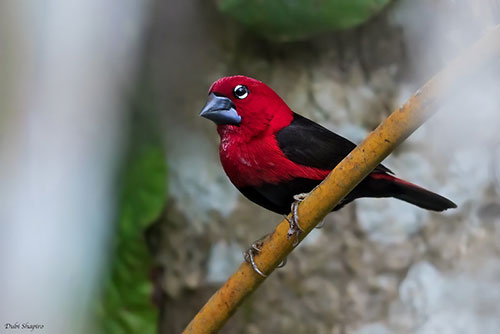
The adult female has red head and throat and from rump to tail. On neck sides, breast and flanks, the feathers may show some red tips.
Rest of plumage is mostly tawny-brown. The wings are blackish-brown with tawny-edged coverts. The bare parts are similar to male.
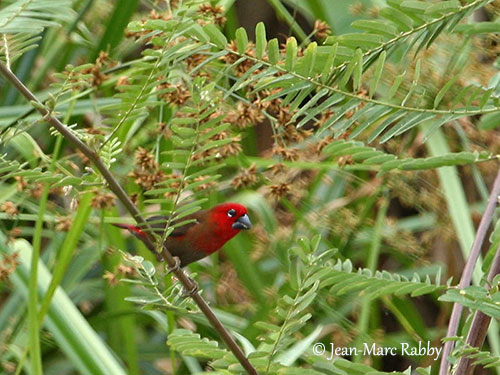
The juvenile/immature resembles female but the head is mostly tawny-brown instead of red. Uppertail-coverts and tail are rufous.
The bill reaches the adult size two months after fledging.
RANGE:
The Black-bellied Seedcracker is native to Central Africa and is a resident species. It is found in SE Ivory Coast, Ghana, Togo, Benin, Nigeria and W and S Cameroon, E to Central African Republic, SW Chad, S South Soudan, Uganda and extreme W Kenya, S to N Angola, Zambia and SW Tanzania.
HABITAT:
The Black-bellied Seedcracker frequents forest undergrowth and edges, marshy areas near forest and moist thickets. It breeds near swamps, marshes, ponds, wet meadows and moist broadleaf forest.
However, as a very adaptable species, it is also found in drier habitats including grassland, savanna and shrubland.
The species also occurs in cacao plantations and even in gardens where it uses bird feeders.
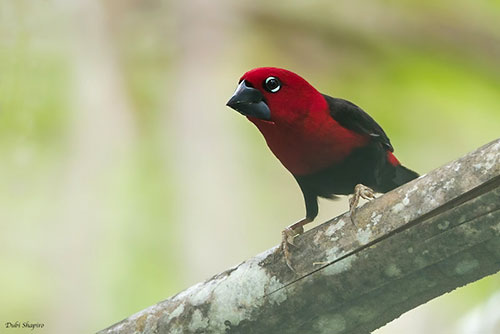
CALLS AND SONGS: SOUNDS BY XENO-CANTO
The Black-bellied Seedcracker gives a soft, repeated “tak” and also a low, metallic “penk” and a hard “trrr”.
The song is a short, fast warbler with variable terminal note described as a sharp “swik”, a hard “turr” and a sibilant “sss rrr”.
The male has several song themes which are not shared with other males. The female sings only occasionally.
There is no vocal difference between small-billed and large-billed individuals.
BEHAVIOUR IN THE WILD:
The Black-bellied Seedcracker feeds on seeds, often those of sedges (Scleria). It may takes soft white seeds or hard-shelled seeds. Bits of green leaves, berries and spiders are also part of the diet. The young are usually fed with soft insect species.
But the diet also varies according to the size of the bill.
The seeds of sedge Scleria verrucosa can be eaten by both small and large-billed birds. But the very hard seeds of Scleria racemosa are only taken by the huge-billed individuals.
The Black-bellied Seedcracker forages on or near the ground. It is usually seen in pair or in small group. If they are disturbed or threatened, the birds quickly dive into the vegetal cover.
When the food is scarce, the three morphs really differ by their specialized diet based on soft to hard and very hard seeds, adapted to the bill’s size.
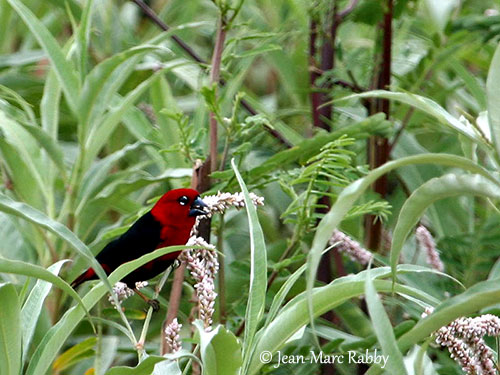
At the beginning of the breeding season, some courtship displays are observed. The perched male bobs up and down while holding a long grass blade, leaf or grass panicle in the bill. Flight displays show the male pursuing the female at great height, flying in a circle of 20-35 metres in diameter. Both mates flap the wings and the male sings.
The females choose their mates based on these displays, but the size of the bill seems to have any impact on mate selection.
They are monogamous during the entire breeding season and stay together during this period.
Both adults build the massive, ball-shaped nest in tree, and share all the nesting duties.
The Black-bellied Seedcracker is resident within its large range.
The flight is fast with rapid wingbeats.
REPRODUCTION OF THIS SPECIES:
The breeding season varies depending on the range, but it takes place mainly during the rains. This period runs from March to November, with peak in April and September.
The abundance of juvenile small-billed and large-billed morphs is closely related to the density of two species of sedges, and the breeding success could be affected by lack of seeds during this period.
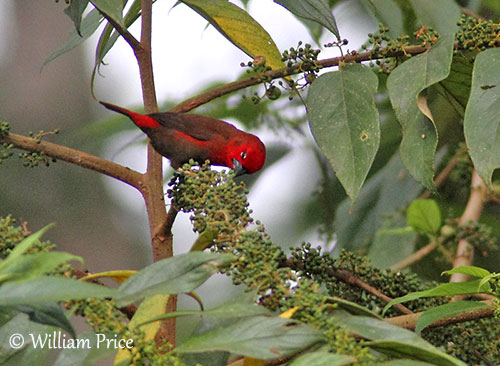
The pair is monogamous during the entire breeding season. Both mates build the nest a few metres from the ground, between 1 and 9 metres in tree, bush or bamboo. The nest is a massive, ball-shaped structure with an entrance on the side. It is made with dry strips of leaves (rattan and bamboo), grass, ferns, bark strips and creepers. All materials are loosely laid or woven together. Inside, the nest is lined with softer grass material.
The female lays 3-5 eggs and both parents share the incubation during 16 days. At hatching, the chicks have elaborate mouth markings and colour. The gape shows three fleshy “balls”. The top one is bright yellow and the lower ones are whiter or pale yellow, and all are bordered black. Other contrasting markings are visible.
The young are fed with soft insects until the bill is formed and hardened. Both adults feed the young.
The juveniles are altricial and stay 24-30 days in the nest before to fledge. They are able to fly when they leave the nest.
PROTECTION / THREATS / STATUS:
The Black-bellied Seedcracker is generally described as uncommon to locally common.
This species is threatened by predation by rats, snakes and feral cats, and it is also affected by harvest and window collision that is regularly increasing with urbanization.
The size of the population is unknown, but it is thought to be stable. The species is described as quite common within the wide range.
The Black-bellied Seedcracker is not considered globally threatened and it is currently evaluated as Least Concern.
